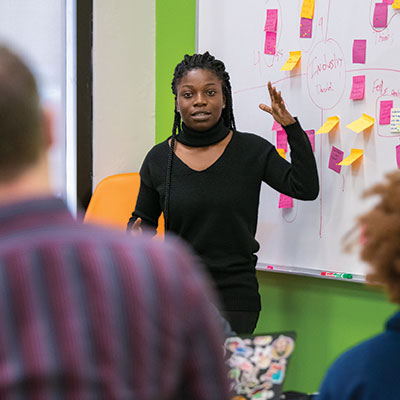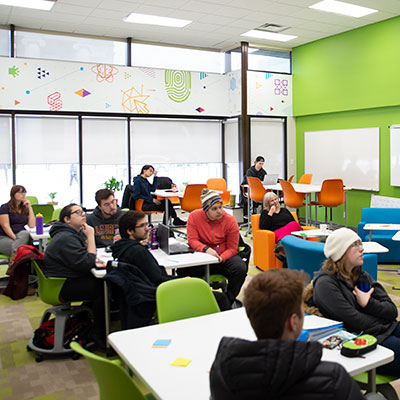Wilfrid Laurier University's Bachelor of Design in User Experience (UX) is a four-year comprehensive degree program – the first of its kind in Canada. UX designers seek to create something new for the world by combining creativity, strategic design-thinking, user research and social awareness.
Students gain the intellectual tools to think critically about the world, and understand how cultural, societal, economic, political and environmental factors contribute to users’ experiences. Students are exposed to the impact that good design has in tech, not-for-profit, government and public sectors. Students work in teams to solve design challenges while contributing to social justice, community building and corporate goals.
Throughout the program, students have opportunities to interact with clients across industries through experiential and work-integrated learning. Students are mentored by industry partners and complete industry projects that reflect real challenges and opportunities in the way humans interact with technology. Students may apply to Co-op at the beginning of their third year of study.

Our program depends on real-world, experiential learning as we connect students to the real world of work. The UX Design program has several options for partners to get involved, with both no-cost and for-a-fee opportunities.
To reinforce pedagogy based on discovery and inquiry, we encourage our clients to partner with faculty in our classrooms on real projects. Over a full term (12 weeks), our students will work through your challenge and come up with creative solutions for a product, service or space.
Help our students meet their career goals. We host cover letter, resume, interview preparation sessions and workshops. We also host portfolio review sessions.
Students compete for admission to co-op, and successful candidates apply for jobs in third year and begin their co-op work term after third year. The extended work term of 12-16 months allows each student to engage in a project of reasonable complexity and see it to completion. Recruitment for UX students begins in December for work terms beginning in May.
Our students are available to run usability testing and other UX services for a fee. This is a great option for partners who know how important UX is for a high-impact product/service, and are looking for creative solutions at a reasonable cost.
We are always coordinating guest speakers from various areas of the UX industry to meet with our students in the classroom, on panels or at other events.
Our Brantford campus is a perfect option for design jams and hackathons, face-to-face or virtually. Have a challenge that needs lots of creative minds to explore? Connect with us!
Our program is growing, and it’s growing quickly. Learn how you can get involved philanthropically with our UX Design program, and contribute to the success of your future designers.

Building on our curriculum, students work in teams tackling real-world problems that exist in industry, not-for-profit, government and the public sector.
Starting with stakeholder empathy as a key tenet, students move through a full cycle of horizon scanning, problem discovery, user research, solution finding, solution evaluation and communication techniques.
Working with and for actual clients, students progress through seven weeklong agile design cycles, culminating in an interactive prototype that is only a few steps removed from a minimal viable product.
Capstone students were challenged with seeking a solution to increase awareness and engagement with their “Workplace Strategies for Mental Health (WSMH)” website. By increasing awareness and engagement with HR Professionals, Canada Life hopes to support the burden of mental health for it’s clients. Through usability testing the team designed an onboarding experience.
Students were asked to explore ways to provide a digital product team with opportunities to virtually co-locate to better facilitate activities like white boarding sessions, stakeholder workshops, group or one-on-one coffee chats, water cooler and kitchen conversations that usually take place in person.
“Flex,” an easy to understand dashboard, was designed to facilitate productivity and social interactions including formal and informal meetings, random and candid conversations and the ability to signal the start and end of the employee’s work day.
Students applied human-centred design in attempting to solve the issue of systematic inequality in the hiring of co-op students within the ODS Lab. With a service design lens the students conducted user research, created personas, a journey map and developed a service design blueprint tackling the ODS co-op hiring process and outreach.
Students designed and built an app called “Bookable” for Europro, a client of Focus21. Europro is a property investment, management and leasing company headquartered out of Toronto and needed an app to help co-shape the future of their leasing spaces.
Students designed the Rink Report App to help the City of Brantford support the many volunteers who maintain the neighborhood ice rinks.
Students were tasked with creating a “Citizen Account Portal” that allows citizens/residents to manage and track all interactions with the region.
The students worked on solutions to reinvent and disrupt the restaurant industry. Through research, ideation, prototyping and testing, they delivered a variety of persuasive solutions which included service design and mobile applications.
Students worked on projects aligned with Unicef Canada, specifically child-led advocacy that teaches kids how to take action and design deliberate change around an issue or problem they care about:
Students conducted focused market research, competitive analysis and applied design thinking methodology to develop a creative digital solution strategy to engage a specific target market.
Students worked on two projects: